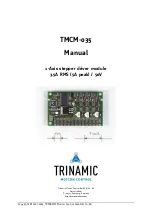
TMCM-035 Manual (V2.09 / February 27
th
, 2009)
14/18
Copyright © 2007-2009, TRINAMIC Motion Control GmbH & Co. KG
Maximum current for fullstep operation (both coils on) is 3.5A (peak value for fullstep is identical
to RMS value!)
For continuous operation above 2.5A RMS a forced cooling is mandatory. The module should not
be mounted in a horizontal position for continuous operation with coil currents above 2.5A RMS.
At a reduced supply voltage, heating will be less. The actual heat dissipation also depends on
the motor!
If the module will be operated near to these limits for extended periods of time, a measurement of
the board temperature in the final application / housing should be done in order to make sure, that
life time is not reduced by module operation near to / above the temperature limits.
4.5
Mixed decay and slow decay
When using the step / direction interface it is possible to switch to mixed decay by setting the USEMD
pin (pin 26) high or to switch to slow decay by pulling the USEMD pin low. When using the analogue
mode use the MDAN and MDBN pins to select between mixed decay and slow decay (pull
MDAN/MDBN low to use mixed decay). When using the SPI interface the mixed decay feature is
controlled by bit 11 and bit 5 of the SPI telegram (please see [TMC239] datasheet for details about the
structure of the SPI telegram).
The mixed decay setting especially at rotation velocities in the range of a few 10 steps per seconds to
several 100 steps per second improves motor behavior (less resonance). However, the actual
performance depends on the motor and mechanics. For supply voltages above 24V and for low
inductivity motors, best microstep behavior is reached when mixed decay setting is continuously on.
Mixed decay should be switched off when StallGuard operational in order to get usable results.
4.6
Microstep resolution adjustments
Step / direction and analog interface support high microstep resolutions. SPI is restricted to 16x
microstepping without external hardware additions described in [TMC236/239/246/249 FAQ] (Extending
the microstep resolution). Since hardware version V2.0 a 64 microstep resolution is possible without
additional hardware, refer to 4.6.2.
4.6.1
Microstep resolution with step / direction interface
When using the step / direction interface it is possible to select the microstep resolution of 8, 16, 32
or 64 microsteps per fullstep. The resolution is since hardware version 2.0 (some labeled TMCM-035 D)
pre-selected with Pin 27 “STEP64EN”. Pin 27 set high or left open selects low resolutions (8 or 16
microsteps), Pin 27 set low (to GND) selects high resolutions (32 or 64 microsteps). The final selection
has to be done by pin 24 “STEP16”, set high or left open the microstep resolution is either 16 or 64
depending on the setting of pin 27. Set low the microstep resolution is either 8 or 32. In former
hardware versions pin 24 sets the TMCM-035 to 8 or 16 microsteps only, and pin 27 has no function.
4.6.2
Increasing Microstep resolution with SPI interface
Even the 16 microstep version of the TMCM-035 can realize more than 16 microsteps via TMC428 SPI
control: Just program the TMC428 for 32 microstep mode. Due to the combination of two DACs driving
the two coils, this results in a resolution somewhere between 20 and 30 microsteps.




































